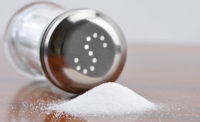Excess intake of sodium can lead to high blood pressure, which is a major cause of cardiovascular diseases. In the U.S., cardiovascular diseases are the most expensive health issue, accounting for 17 percent of national health expenditures. It was estimated that with a 15 percent reduction in population sodium intake, over 10 years, 8.5 million deaths could be averted from cardiovascular-related deaths worldwide (Asaria et al., 2007).
In the U.S., roughly 80 percent of sodium is consumed in processed foods such as bread, canned soup, prepared ready-to-eat meals and lunchmeat products. The average sodium intake in the U.S. is approximately 3,400mg per day, which is almost 50 percent higher than the U.S. dietary guideline of 2,300mg per day. Because the current U.S. average sodium intake is much higher than the dietary guideline and the majority of sodium is consumed in processed foods, the U.S. food industry has undertaken an important task to reduce sodium in processed foods.
The task to reduce sodium presents a challenge to the lunchmeat industry because most sodium sources in lunchmeat products are coming from important functional ingredients such as salt, phosphates and antimicrobials. Depending on the target percentage of sodium reduction, the usage of more than one of the listed ingredients may need to be reduced.
Salt
Salt, or sodium chloride, is one of the most important functional ingredients in lunchmeat products, not only it solubilizes myofibrillar proteins and produces the desired texture, it also inhibits the growth of unwanted microorganisms. In general, salt is used in the range of 1.5 to 2.0 percent in lunchmeat products, accounting for about 50 percent of the total sodium. Due to the similarity in molecular function and taste perceived, to reduce sodium, potassium chloride is often used to replace sodium chloride. Potassium has a higher molecular weight than sodium (39 vs 23 g/mol). To achieve the same level of protein extraction, when the total amount of salt in the formula is less than 1.5 percent, it is important to replace the amount of reduced sodium chloride with the same molar concentration of potassium chloride.Sea salt is another ingredient that is commonly used to reduce sodium. Depending on the source, process and manufacturer, sea salt contains variable amounts of trace minerals (zinc, iron, manganese, potassium, etc.) and less sodium, and the trace minerals in sea salt could act as a flavor enhancer when regular salt is replaced by sea salt. Other ingredients such as magnesium chloride and calcium chloride have been experimented to reduce sodium; however, due to the metallic taste and their poor ability to extract proteins, not much success has been achieved.
Phosphates
Phosphates are added to lunchmeat products to increase water-binding capacity and improve yield. In the U.S., phosphates are permitted to be used at levels of up to 0.5 percent of the total formula, and typically in lunchmeat products, phosphates are used in the range of 0.2 to 0.5 percent, accounting for about 14 percent of the total sodium. When phosphates are added, it increases ionic strength. As a result, actomyosin is dissociated into actin and myosin, and more sites on the proteins are free to bind water. Sodium phosphates have a long history in lunchmeat products and among all the sodium phosphates, sodium tripolyphosphate is the most commonly used in lunchmeat. To reduce sodium, a variety of sodium and potassium phosphate blends with different types of phosphates (mono, pyro, and tri) are available. Because no one phosphate can do everything, depending on the target percentage of sodium reduction, it is important to use the right types of phosphate blends, so not only the target sodium reduction can be achieved, texture and flavor of the sodium reduced products can also be maintained. Currently, commercial sodium and potassium phosphate blends with 0 to 100 percent potassium phosphates can be purchased. Because potassium has a higher molecular weight than sodium, to achieve the same texture and cook yield, when potassium blends are used with 100 percent potassium phosphate, it may be necessary to increase potassium phosphate blends.
Antimicrobials
Listeriosis is a major public health concern and can cause death especially in young kids, older adults and people with compromised immune systems. Listeriosis is caused by Listeria monocytogenes and unlike most bacteria, Listeria can grow under refrigerated conditions (35 to 40°F). Because lunchmeat products are stored under refrigerated conditions, this particular nature of Listeria makes it a major concern for lunchmeat industry.
To inhibit the growth of Listeria, sodium-based antimicrobials have been successfully used in lunchmeat products. Depending on product chemistry (moisture, salt, pH, and nitrite) and shelf life, it can constitute up to around 35 percent of the total sodium in in lunchmeat products. The advance in processing and purification technologies in the food antimicrobial industry has improved the flavor of potassium-based antimicrobials dramatically. But to achieve the same level of Listeria control as sodium-based antimicrobials, higher amounts of potassium-based antimicrobials would be needed. Recently, the U.S. Department of Agriculture (USDA) has approved the use of antimicrobials such as sodium benzoate and sodium propionate which are much more effective for Listeria control in reduced-sodium lunchmeats. But the use of those antimicrobials comes with the adverse effects on flavors.
High-pressure pasteurization (HPP) is an alternate way to provide the food safety needed in lunchmeat. In 2003, the USDA approved the use of HPP as a post-packaging Listeria control in ready-to-eat meat and poultry products. HPP decontaminates foods by interrupting cellular functions of the target microorganisms with minimal impact on product quality, flavor and nutritional values. In recent years, due to increased consumer demand for natural and organic products, it has gained its popularity, especially among consumers who are looking for clean-label products.
With the use of HPP, the antimicrobial can be removed and up to 35 percent of sodium can be reduced without any adverse effects on product safety and quality. The advantage of HPP process does not come without cost. The high costs of the HPP equipment, installation and maintenance and limited production throughput are the major hurdles for HPP process; however, those hurdles can be overcome by the higher return-on-investment rate and carefully designed production lines and plans. Other technologies such as surface spraying, irradiation and bacteriophage are also available for Listeria control, but the efficacy of those technologies still needs to be validated.
Processing
When salt and phosphates are reduced or replaced by other ingredients, certain procedures can be used to maximize protein extraction and maintain the desired product yield and texture. Needle injection delivers brine into the muscles. When followed by tumbling, the combined process can promote muscle interaction and liberate the proteins from muscle cells, thereby maximizing protein extraction. Experience has demonstrated that a slow and gentle tumble can relax the muscles and a longer tumble time would allow the proteins to swell and be released. When programmed with interval tumbling (resting between each tumble cycle), it is an effective method to maximize protein extraction. When needed, ground trims could be added to increase the amount of surface proteins, and binders such as carrageenan and starches can be added to maintain the texture and control purge.
Flavors
Sodium is the main mineral that can produce salty taste. Due to the unique sodium-specific transduction mechanism on the taste receptors, the quality and intensity of salty taste elicited by sodium from sodium chloride is superior to any other ingredients that contain sodium. Lithium and potassium are two other minerals that can produce salty taste. Due to its toxicity, lithium is not used in food, and potassium is the most common ingredient used to replace sodium.
Flavors are determined by interactions of multiple sensory inputs including visual, smell, texture and chemical irritation. What’s perceived as a flavor is the result of complex interactions between a food matrix and human sensory processed and decoded by the brain. As a result, sodium reduction in lunchmeat products will have multiple flavor effects. Certain measures can be taken to rebalance and compensate the missing flavors.
When quality and intensity of the salty taste induced by sodium chloride is high enough, it could suppress the bitter flavor produced by other ingredients such as potassium. When reducing sodium, if possible, sodium coming from ingredients other than sodium chloride should be reduced first. By doing so, it could maintain the desired flavor and texture.
When a noticeable flavor difference is not preferred, other ingredients can be used to amplify the salty taste. Paired with ingredients rich in glutamates, nucleotides such as IMP (disodium 5’ inosinate) and GMP (disodium 5’ guanylate) can amplify the salty taste. Yeast extract and autolyzed yeast extract are high with naturally occurred glutamates and nucleotides. A small amount of yeast extract is only needed to improve the perception of salty taste and enhance the overall flavor profile. Other ingredients such as organic acids, amino acids and minerals can be used to activate the chemical irritation and improve the flavor intensity and duration stimulated by sodium.
Conclusion
The specificity of sodium in producing salty taste makes sodium reduction in lunchmeat products challenging. When reducing sodium, all aspects of the products should be considered and the task should be carefully executed to avoid any adverse effects in product quality and safety. Sodium reduction will most likely reduce the appeal of foods; however, studies have shown that small, incremental decreases in sodium would be acceptable to the human palate. The gradual sodium reduction approach has shown great success to reduce average U.K. population salt intake. As the U.S. food industry takes on the sodium-reduction task, the gradual approach would also be recommended. NP








Report Abusive Comment